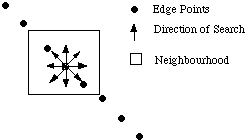
Most edge detectors yield information about the magnitude of the gradient at an edge point and, more importantly, the direction of the edge in the locality of the point.
This is obviously useful when deciding which edge points to link together since edge points in a neighbourhood which have similar gradients directions are likely to lie on the same edge.
Local edge linking methods usually start at some arbitrary edge
point and consider points in a local neighbourhood for similarity
of edge direction as shown in Fig. 29.

If the points satisfy the similarity constraint then the points are added to the current edge set.
The neighbourhoods based around the recently added edge points are then considered in turn and so on.
If the points do not satisfy the constraint then we conclude we are at the end of the edge, and so the process stops.
A new starting edge point is found which does not belong to any edge set found so far, and the process is repeated.
The algorithm terminates when all edge points have been linked to one edge or at least have been considered for linking once.
Thus the basic process used by local edge linkers is that of tracking a sequence of edge points.
An advantage of such methods is that they can readily be used to find arbitrary curves.
Many strategies have been adopted to control the search and selection processes used for edge linking.
One such possibility is to use relaxation labelling techniques which we will discuss later.
The basic idea is to find sets of edges. Here the assignment of each edge point to an edge is based on a probability estimate that the particular edge point and its local neighbours lie on the same edge.
Other methods have posed the edge linking problem as